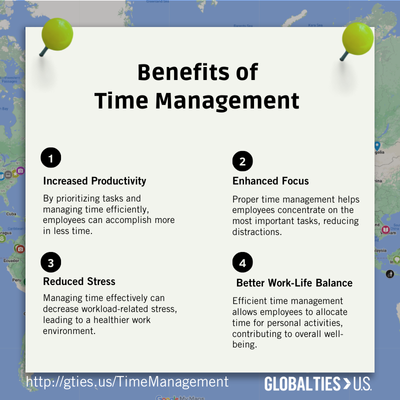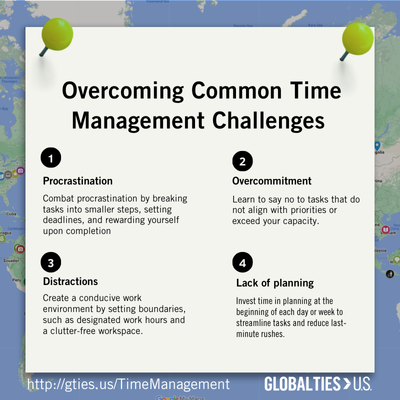 by Pete Botjer, Program Associate, Membership
by Pete Botjer, Program Associate, Membership
Editor’s Note: This is a piece on effective time management. Drawing on professional development coursework learned from Pryor Learning, the author shares ideas on what individuals can do to manage their time effectively to increase productivity and reduce stress.
Time management is a critical skill in the workplace. It is essential for achieving productivity, reducing stress, and maintaining a healthy work-life balance. In today’s fast-paced work environment, effective time management can be the difference between success and burnout.
As part of my work on the Training and Community Development Team at Global Ties U.S, I provide our 80+ community-based nonprofit organizations with onboarding, community-building, and programmatic support to strengthen their organizations. I recently took a professional development course through Pryor Learning, which encouraged me to reflect on my own time management and how I could better support our Network in balancing their projects, programs, and day-to-day life. Below are some key strategies I learned about improving time management at work to become more productive and less stressed.
Understanding Time Management
Time management begins with consciously understanding how much time is spent on specific activities to increase effectiveness, efficiency, and productivity. Often, the time planned for an activity and the time spent on the activity are not the same. Given the high volume and complexity of activities members of the Global Ties Network coordinate for the International Visitor Leadership Program (IVLP) and other international exchange programs, meticulous planning and scheduling is crucial to ensuring smooth execution. Good time management enables individuals to complete more tasks in less time, thereby improving job performance and reducing stress.
Often, we think being busy means we are effectively managing our time. While learning more about time management, I saw many references to author Tim Ferris who has focused his career on lifestyle optimization. Tim correlates keeping busy all the time with being lazy because business can be a sign that we only know what we need to do, not what is important.
People often struggle with time management because they hyper-focus on the task in front of them rather than stepping back to see the bigger picture. For example, when a request from a high-priority partner or client comes in, people may feel that they need to drop everything to meet that request. Author Stephen Covey, an expert on time management, writes that taking charge of your work allows you to take charge of your life. Covey notes that there are things that we can control and things that we cannot control. Effective time management in the workplace allows people to take control of what they can (i.e. their time), and has several benefits.

Key Strategies for Time Management
Peter Drucker was a management consultant, educator, and author whose writings had a vast impact on how we view modern management theory today. Drucker’s theory was that what gets measured gets managed. There are several ways to measure and manage your time, including the use of digital or physical planners, setting time limits, and eliminating distractions, but these strategies are often so broad they are difficult to implement.
One key strategy for time management is setting SMART goals. Smart goals are Specific, Measurable, Achievable, Relevant, and Time-bound. Creating SMART goals helps to create clear and attainable goals that provide direction and create a sense of accomplishment upon completion.
Another time management strategy is weekly block planning. Weekly block planning involves:
- Identifying Seven Priorities: Determine your seven key priorities for the week, one for each day. These priorities should align with your most important goals and tasks.
- Scheduling Mandatory Meetings: Write in all mandatory meetings and fixed appointments for the week. This provides a framework around which to organize other tasks.
- Filling in the Blanks: Based on a personal assessment of your abilities and workload, fill in the remaining time blocks with your projects and tasks. Be realistic about what you can accomplish in the given time.
- End-of-Week Review: At the end of the week, review how well you adhered to your original plan. Assess which tasks were completed, which were postponed, and why.
- Adjusting the Plan: If you didn’t stick to the plan, this is a good time to reevaluate and determine how to adjust your strategy for the following week. Identify any patterns of distraction or underestimation of task durations.
- Continuous Improvement: Continuously repeat this process of planning, executing, reviewing, and adjusting. Over time, this will enhance your ability to manage time effectively and increase productivity.
Using Drucker’s theory that what gets measured gets done, we can use this weekly plan to take an honest look at our priorities and adjust them as needed. What is great about this method of time management is its flexibility. When your schedule starts to feel out of control, try this method to identify what needs the most attention.
Overcoming Common Time Management Challenges
While strategies like setting SMART goals and block planning are good steps toward more effectively managing your time, another part of time management involves overcoming common challenges or avoiding bad habits. 
Another common challenge is juggling multiple tasks at once. The Global Ties Network engages thousands of diverse stakeholders, and managing their availability and involvement requires careful scheduling. It’s easy to fall into the trap of thinking that you can do multiple things at once. Author Dave Crenshaw disputes this idea in his book The Myth of Multitasking, which notes that multitasking is often less effective because the human brain isn’t designed to handle multiple tasks simultaneously with efficiency.
There are eight easy steps for day-to-day stress reduction that will help you overcome common time management challenges:
- Schedule leisure time and commit to it
- Find ways to laugh
- Consciously slow down when you’re not working
- Change negative self-talk to positive
- Continually search for a change of scenery
- Rethink what you eat
- Exercise
- Consistently focus on what you can control
Leveraging Technology for Time Management
Technology offers numerous tools and apps designed to enhance time management. There are a variety of tools that Global Ties U.S. uses to keep ourselves on task.
- Basecamp: Basecamp enhances time management for Global Ties U.S. by centralizing project management, task tracking, scheduling, and communication. Its tools ensure timely task completion, and improve overall productivity.
- Microsoft Outlook: Microsoft Outlook offers robust tools for email management, calendar scheduling, and task organization. Its integrated calendar allows users to schedule meetings, set reminders, and view upcoming deadlines, while the task management feature helps prioritize and track tasks.
- Salesforce: Salesforce allow Global Ties U.S. to better centralize key data on marketing, fundraising, contact information, events, and more activities, which saves users time by organizing everything in one place.
Conclusion
Effective time management strengthens the Global Ties Network. By prioritizing tasks, setting clear goals, using organizational tools, and eliminating distractions, members can enhance productivity and reduce stress. Developing and maintaining good time management habits improves work performance and helps us to coordinate numerous programs and activities, engage diverse stakeholders, optimize resources, and manage volunteers. All these tasks are critical to achieving our mission of fostering international connections and advancing U.S. strategic priorities. Remember, managing time well is a continuous process of self-improvement. Keep learning.
